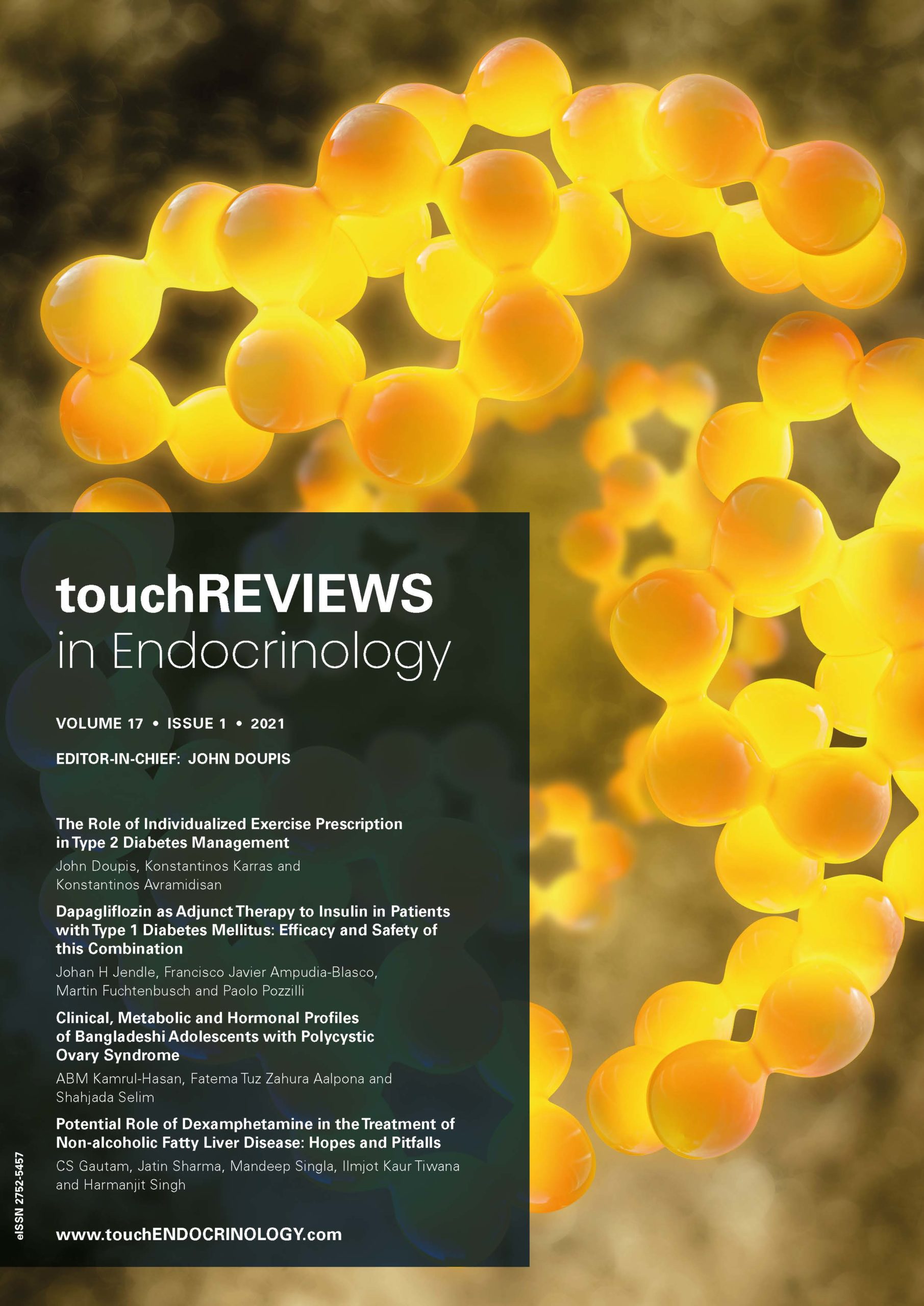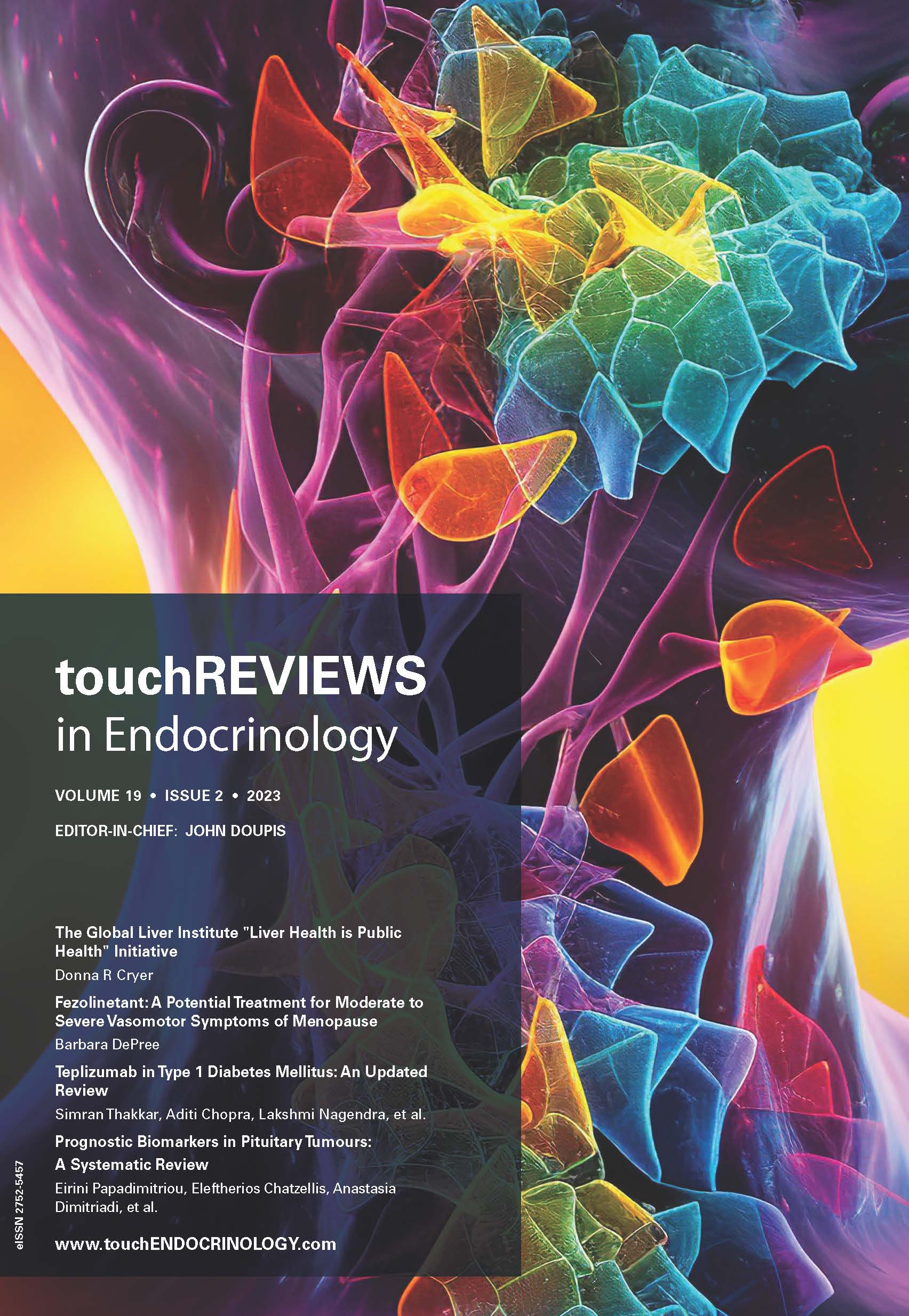touchREVIEWS in Endocrinology Volume 17, Issue 1, 2021
Welcome to the spring 2021 edition of touchREVIEWS in Endocrinology (formerly European Endocrinology).
In this issue, our Editor-in-Chief, John Doupis, introduces the issue and the decision to rename and widen the reach of the journal. We continue to provide the same great free-to-access article content across clinically relevant topics in endocrinology, including diabetes, endocrine oncology and reproductive endocrinology, while also aiming to grow the journal in an increasingly global research community.
We want to take this opportunity to extend our thanks to all authors who contributed to this issue, and all editorial board members who provide their ongoing support. We are now welcoming submissions to our autumn 2021 edition. If you’re interested in submitting an article, please don’t hesitate to contact us directly. We hope you enjoy this issue!
Foreword
Welcome to the latest issue of the newly-renamed touchREVIEWS in Endocrinology, previously European Endocrinology. The decision to rename and widen the reach of the journal has been taken after a great year for touchENDOCRINOLOGY, and we feel that in an increasingly global research community, submissions were being limited by an assumed primary reach to one regional […]
Editorial
Diabetes mellitus is a chronic disease that affects many people around the world. Sedentary lifestyle is considered a main risk factor for type 2 diabetes mellitus (T2DM). As presented in this editorial, the advantages of activity in preventing and treating T2DM are widely recognized. Exercise training improves glycaemic control, body composition, cardiorespiratory wellness, physical functioning […]
Special Report
Wounds on the feet, known as diabetic foot ulcers (DFUs), are a major complication of diabetes. DFUs can become infected, leading to amputation of the foot or lower limb. Patients who undergo amputation experience significantly reduced survival rates.1 In previous studies, researchers have achieved high accuracy in the recognition of DFUs using machine learning algorithms.2–5 […]
Reviews
The prevalence of diabetes type 1 (T1D) and type 2 (T2D) is increasing worldwide; the number of people with diabetes was 463 million in 2019, but it is estimated to reach 700 million by 2045.1 The incidence of T1D is increasing in most countries.1 Age- and sex-standardized incidence rates from 1998 to 2013 (up to 25 years) […]
Immune checkpoints are small molecules that are present on the cell surface of T lymphocytes to regulate the immune response. While some of these molecules enhance the stimulatory signals, others boost the inhibitory signals to blunt the activity of T lymphocytes (intrinsic down-regulators of immunity).1 The stimulatory checkpoints include CD28 – a family of receptors […]
Non-alcoholic fatty liver disease (NAFLD) is the most frequent cause of chronic liver disease globally; it is histologically classified into non-alcoholic fatty liver (NAFL) and non-alcoholic steatohepatitis (NASH).1 NAFL is characterized by the presence of >5% of hepatic steatosis without evidence of hepatocellular injury in the form of hepatocyte ballooning. NASH is the advanced stage of […]
Polycystic ovary syndrome (PCOS) is a heterogeneous syndrome, considered the most common endocrinopathy in women of reproductive age, with a prevalence of 6–8% in premenopausal women.1,2 However, long-term sequelae are extended beyond the reproductive axis, being present from birth to senescence. Consequently, early detection and treatment options are in high demand to prevent long-term complications. This […]
Original Research
Polycystic ovary syndrome (PCOS) is a heterogeneous androgen-excess disorder that presents with different degrees of reproductive and metabolic dysfunctions; it is also associated with insulin resistance and metabolic syndrome.1 The global prevalence estimates of PCOS in women of reproductive age are highly variable, ranging from 5% to 18%.2 This could be due to the lack of a […]
Case Reports
Renal tubular acidosis (RTA) is characterized by the impaired ability of the kidneys to absorb filtered bicarbonate or to excrete titrable acid in urine.1 It manifests as normal anion gap (hyperchloremic) metabolic acidosis. RTA may be of four types: type 1 (distal RTA), type 2 (proximal RTA), type 3 (mixed RTA) and type 4.1 Type 1 […]
Acromegaly is a chronic, progressive disease characterized by an excess secretion of growth hormone, and consequently, increased circulating insulin-like growth factor 1 (IGF-1) levels. These patients typically exhibit acral and soft tissue overgrowth, headache, arthritis and visual disturbances. Impaired glucose tolerance and diabetes mellitus are also frequently associated with acromegaly.1 We describe a patient who […]
Oncocytomas are epithelial tumours composed of cells with eosinophilic, mitochondria-rich cytoplasm.1 They can occur in various organs, such as the kidneys, thyroid, pituitary gland, salivary glands and parathyroid glands. Rarely, it has been reported in the respiratory and gastrointestinal tracts.2–4 Adrenal oncocytomas are extremely rare, with nearly 200 published cases since Kakimoto et al. reported the first […]
Postmenopausal state is associated with changes in the hormonal milieu characterized by reduced oestrogen, increased gonadotrophins and a small increase in testosterone levels.1,2 As a result, it is not uncommon for women in postmenopausal age group to show mild increases in androgen-driven hair growth.3,4 However, rapidly progressive hirsutism, acne and male-pattern alopecia in women warrants a search […]
Rare catecholamine-secreting tumours that arise from the adrenal medulla and sympathetic ganglia are referred to as pheochromocytomas (PHEO) and paragangliomas, respectively.1 The annual incidence of PHEO in general population is approximately 2–8 cases per million.2 The age onset is typically the fourth decade of life.3 It occurs in less than 0.2% of patients with hypertension.4–7 Symptoms are present in […]

Trending Topic
Thyroid nodules are common worldwide, and their prevalence is increasing. Most nodules are asymptomatic and detected incidentally on cross-sectional imaging or physical examination. In rare cases (10–15%), nodules are malignant and require diagnostic evaluation. Even malignant nodules frequently show non-aggressive behaviour.1 The increase in the incidence of thyroid cancer is unfairly distributed globally, and the […]
Journal Archive
touchREVIEWS in Endocrinology (previously European Endocrinology) is a peer-reviewed, free-to-access, bi-annual journal comprising review articles, case reports, editorials, special reports and original research. It features balanced and comprehensive articles written by leading authorities, addressing the most important and salient developments in the field of endocrinology.
Latest articles videos and clinical updates - straight to your inbox
Log into your Touch Account
Earn and track your CME credits on the go, save articles for later, and follow the latest congress coverage.
Register now for FREE Access
Register for free to hear about the latest expert-led education, peer-reviewed articles, conference highlights, and innovative CME activities.
Sign up with an Email
Or use a Social Account.
This Functionality is for
Members Only
Explore the latest in medical education and stay current in your field. Create a free account to track your learning.


















